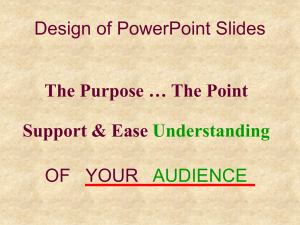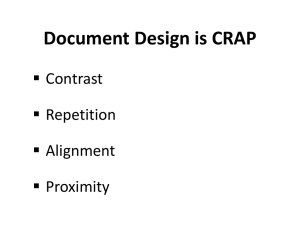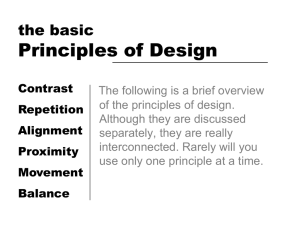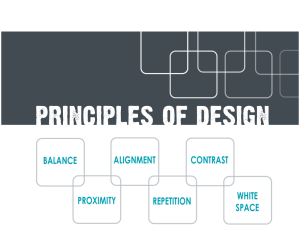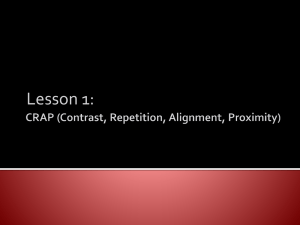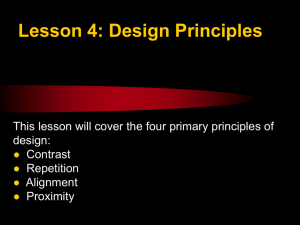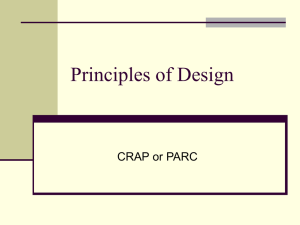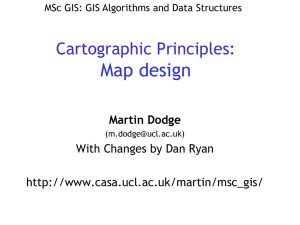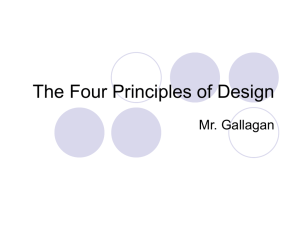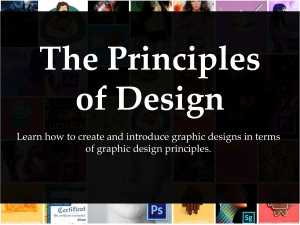The Non-Designer’s Design Book Design and Typographic Principles for the Visual Novice
advertisement
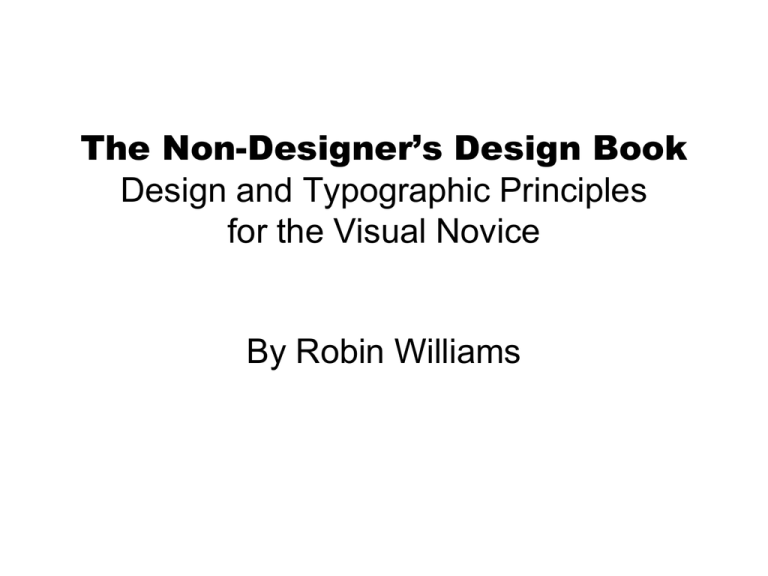
The Non-Designer’s Design Book Design and Typographic Principles for the Visual Novice By Robin Williams Main Design Strategies Proximity Alignment Repetition Contrast Summary of Proximity • When several items are in close proximity to each other, they become on visual unit rather than several separate units. • Items relating to each other should be grouped together. • Be conscious of where your eye is going: where do you start looking; what path do you follow; where do you end up; after you’ve read it, where does your eye go next? • You should be able to follow a logical progression through the piece, from a definite beginning to a definite end. Purpose of Proximity • The basic purpose of proximity is to organize. • Other principles come into play as well, but simply grouping related elements together into closer proximity automatically creates organization. • If the information is organized, it is more likely to be read and more likely to be remembered. • As a by-product of organizing the communication, you also create more appealing (more organized) white space. How to Get it • Squint your eyes slightly and count the number of visual elements on the page by counting the number of times your eye stops. • If there are more than three to five items on the page (of course it depends on the piece), see which of the separate elements can be grouped together into closer proximity to become one visual unit. What to Avoid • Avoid too many separate elements on a page. • Don’t stick things in the corners and in the middle. • Avoid leaving equal amounts of white space between elements unless each group is part of a subset. • Avoid even a slip second of confusion over whether a headline, a subhead, a caption, a graphic, etc., belongs with its related materials. Create a relationship among elements with close proximity. • Don’t create relationships with elements that don’t belong together. If they are not related, move them apart from each other. Summary of Alignment • Nothing should be placed on the page arbitrarily. • Every element should have some visual connection with another element on the page. • Unity is an important concept in design. To make all the elements on the page appear to be unified, connected, and interrelated, there needs to be some visual tie between the separate elements. • Even if the separate elements are not physically close on the page, they can appear connected. • Take a look at designs you like. No matter how wild and chaotic a well-designed piece may initially appear, you can always find the alignments within. Purpose • The basic purpose of alignment is to unify and organize the page. The result is kind of like what happens when you pick up all the toys that were strewn around the living room floor and put them all into one toy box. • It is often a strong alignment (combined, of course, with the appropriate typeface) that creates a sophisticated look, or a formal look, a fun look, or a serious look. How to get it • Be conscious of where you place elements. • Always find something else on the page to align with, even if the two objects are physically far away from each other. What to Avoid • Avoid using more than one text alignment on the page (that is, don’t center some text and rightalign other text). • Try to break away from centered alignment unless you are consciously trying to create a more formal, sedate (often dull?) presentation. • Choose centered alignment consciously, not by default. Summary of Repetition • A repetition of visual elements throughout the design unifies and strengthens a piece by tying together otherwise separate parts. • Repetition is very useful on one-page pieces and is critical in multi-page documents (where we often just call it being consistent). Purpose • The basic purpose of repetition is to unify and to add visual interest. • Don’t underestimate the visual interest of a page -- if a piece looks interesting it is more likely to be read. How to get it • Think of repetition as being consistent. • Then push the existing consistencies a little further – can you turn some of those consistent elements into part of the conscious graphic design, as with the headline? • Do you use a 1-point rule at the bottom of each page or under each heading? How about using a 4-point rule instead to make the repetitive element stronger and more dramatic. How to get it • Take a look at the possibility of adding elements just to create a repetition. • At first simply find existing repetitions and then strengthen them. • As you get used to the look, start to create repetitions to enhance the design and the clarity of information. What to Avoid • Avoid repeating the element so much that it becomes annoying or ovewhelming. • Be conscious of the value of contrast. Summary of Contrast • Contrast on a page draws our eyes to it; our eyes like contrast. • If you are putting two elements on the page that are not the same (such as two typefaces or two line widths), they cannot be similar. • For contrast to be effective, the two elements must be very different. Basic Purpose • The basic purpose of contrast is two-fold, and both purposes are inextricable from each other. – One purpose is to create an interest on the page – if a page is interesting to look at, it is more likely to be read. – The other is to aid in the organization of the information. A reader should be able to instantly understand the way information is organized, the logical flow from one item to another. • The contrasting elements should never serve to confuse the reader or to create a focus that is not supposed to be a focus. How to get it • Add contrast through things like: – – – – – – typeface choices line thicknesses Colors Shapes Sizes space • It is easy to find ways to add contrast, and it’s probably the most fun and satisfying way to add visual interest. • The important thing is to be strong. What to Avoid • Don’t be shy. If you’re going to contrast, do it with strength. • Avoid contrasting a sort-of-heavy line with a sort-ofheavier line. • Avoid contrasting brown text with black headlines. • Avoid using two or more typefaces that are similar. • If the items are not exactly the same, make them different.
